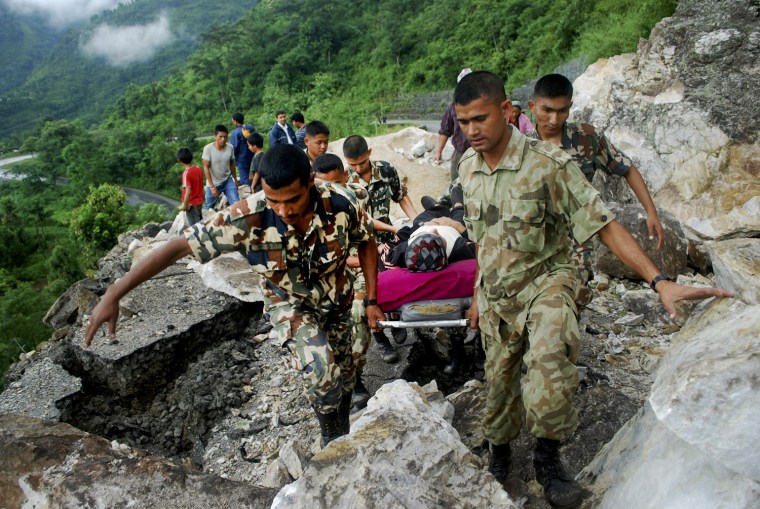Thousands of homeless villagers in the Himalayas spent a miserable night outdoors in heavy rains after a powerful earthquake flattened houses and rescuers struggled to reach victims in the mountains of India, Nepal and Tibet.
Rescue workers with helicopters and earth movers ferried supplies and dug through mudslides trying to reach villages cut off by the quake that killed 53 people and damaged more than 100,000 homes.
The weather slowed the relief effort, and many homeless villagers spent Monday night outside.
Three emergency workers were killed in the frantic rescue effort, Indian Home Secretary R.K. Singh said. More than 6,000 army and paramilitary troops were working to clear concrete slabs, bricks and mud to rescue scores of people trapped under houses that collapsed when the 6.9-magnitude quake struck the Himalayan region Sunday evening.
"The situation doesn't look good," an official from the U.N.'s disaster management team in New Delhi told Reuters. "My feeling is the death toll and number of injured are going to increase."
Nine helicopters dropped food to villages, airlifted a medical team, evacuated the injured and conducted damage assessments, Singh said. Heavy construction equipment was used to clear some of the blocked roads, he said.
"The rescue and relief operations are in full swing though they were hampered ... by poor weather," Singh said.
By midday Monday, workers had managed to clear mudslides from one lane of the main highway leading to the Indian state of Sikkim, where the quake was centered near the Nepal border, Singh said. An initial convoy of 75 paramilitary soldiers started moving toward Mangan, the village closest to the epicenter, but still had not arrived by evening.
At least 32 people died and 100 others were injured in Sikkim, Singh said. At least 10 of them worked for the same hydroelectric project, but it was not immediately clear how they died.
Seven other people were killed in the neighboring Indian states of Bihar and West Bengal, Singh said.
People in Sikkim's main city, Gangtok, sat on roadsides under umbrellas in the heavy rain and prepared for another chilly night -- reluctant to go home for fear of aftershocks.
"We are scared of another earthquake like last night, we have no place to stay, our house is damaged, and we can only pray to God now," Sushma Sharma, mother of three children in Gangtok, told Reuters.
China's official Xinhua News Agency reported seven deaths and 24 injuries in Tibet. It said the quake triggered hundreds of landslides that disrupted power and water supplies.
Nepal's government said seven people died there, including two men and a child who were killed when a brick wall toppled outside the British Embassy in the capital, Katmandu. Nearly 70 people were injured, some of them seriously, and were in hospitals across Nepal.
Most of the deaths in India occurred when houses, already weakened from recent monsoon rains, collapsed due to the force of the quake. More than 100,000 homes were damaged in Sikkim state alone, state officials said.
Singh said it was still unclear what the final toll might be.
"There may still be villages where people are trapped under collapsed houses that we have not been able to reach," he said.
TV broadcasters showed footage of buildings buckled, sidewalks cracked and two major roads collapsed in Gangtok, Sikkim's capital, 42 miles (68 kilometers) southeast of the quake's epicenter. Police cordoned off the office of the state's top elected official after the building was severely damaged, police Chief Jasbir Singh said.
In West Bengal state, utility workers toiled to restore power to a large swathe of the state which plunged into darkness after power lines were snapped by the quake.
The region has been hit by major earthquakes in the past, including in 1950 and 1897.
